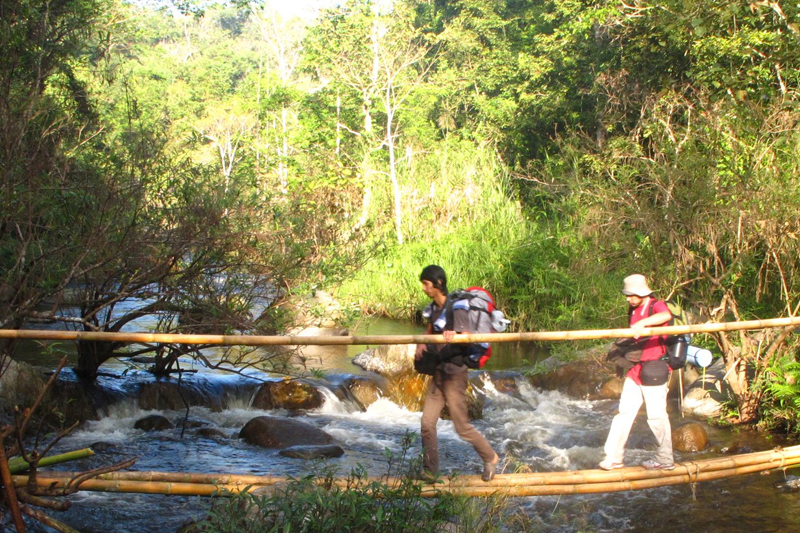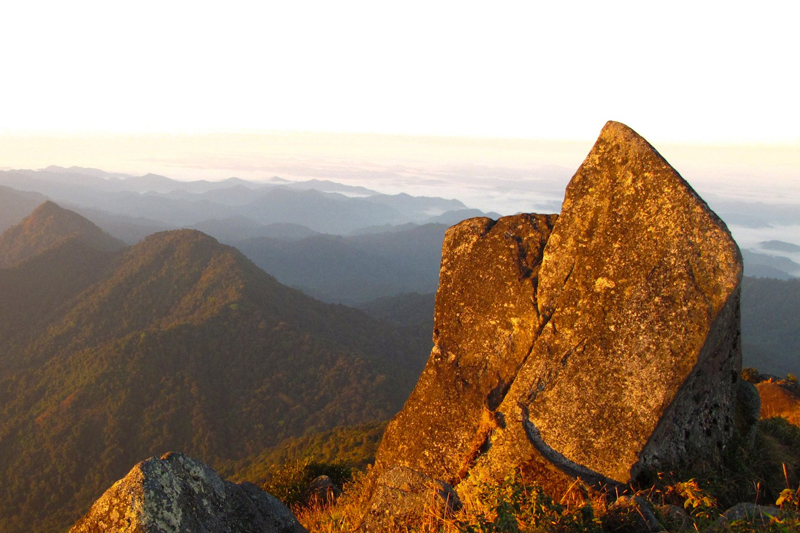In the poster, Mokoju Peak is irresistible: a dome of bald rock carpeted by a florid treeless meadow, overlooking a bottomless valley. The peak thrusts high into the blue Kamphaeng Phet’s sky rather like a giant mother hen guarding her chicks. The ridge lines that arch from the peak lead your eyes to a panoramic wall of mountains. At 1,964 metres, Mokoju is one of Thailand’s highest peaks and it guards Huai Kha Khaeng Wildlife Sanctuary – the country’s last biological frontier.
“Mokoju earns its name from Karen tribe. It means “it looks like it’s going to rain”. You often see the mountain crowned by columns of cloud,” says Yong, a 40-something hilltribe man who’s the leader of our porters. “Up there, on the top of Mokoju Peak, you’re above the forest and even the cloud. The canopy looks like broccoli.”
Mokoju Peak, thank to its panoramic beauty, draws the hiker’s eye. The five-day Mokoju trail trek, up and down, takes you over 60 kilometres of uncountable bottomlands, steep ridgelines and challenging summits, ending at the Mokoju Base Camp, 1,890m above sea level.
Our first 24 hours on the Mokoju Trail lead us – 10 seasoned trekkers – up the high, rugged terrain of Mae Wong National Park and through the first summit – mor kheetaek, literally “shitty summit”. The mountain earned its nasty name from those with untrained legs, and Bang, our unofficial team leader, soon realises why. Halfway up, Bang sheds his US Army jacket. Before the first break, he’s also given up his camera backpack and military boots.

“We share the trails with the wildlife,” notes Withawat, the forest ranger, pressing his hiking shoe into a pile of dried dung, which he says was dropped by a wild cat or tiger. “From November to February, the hiking season, we own the trail. The rest of the year belongs to them.”
The second day sees us hiking along a dirt trail that twists through the bamboo forest. We see spiders, eye-catching mushrooms, leeches and other blood-sucking insects. Once in a while, we spot piles of animal dung. American classic hiking trails might be marked by posts and signs, but here in the evergreen forest of Mae Wong National Park our trail is certified by elephants, tigers and gaur.
On the second night, we pitch our tents beside a stream. Yong and his team make a fireplace from three pieces of stone and we whip up fried sausages and canned sardines. Yong goes downstream, and returns with handful of young fern. The choices are deep-fried or stir-fried. It tastes a bit better, I observe, than licking your hiking pole. When it’s time for a snack, we press sour pieces of wild fruit in “tribal seasoning” (monosodium glutamate, actually) and wash it down with a gulp of Smirnoff – a true Russian elixir!


We share the night with a collection of Mokoju oddballs, Yong’s cooking (of course) and laughter over stories of a “snoring tiger” and my falling out of the hammock while asleep the previous night.
The third day brings us each face to face with the discomfort demons. Mokoju Trail, with all its challenges, stretches out nine kilometres along a steep ridgeline that’s used in the rainy season by herds of gaur. The gaur, have no problem jumping the gruelling, steep path, but we’re different.
One foot in front of the other, we begin the hike walking in a small group, but soon we find ourselves spread out along the trail, each man and woman alone with their thoughts. Legs burn, knees protest, and soft feet chafe and blister. Backpacks are still loaded with camera gear and water, as well as extras yet to be jettisoned.
“I have an idea,” puffs Lek, a freelance photographer, as we lean against a rock. “Perhaps, I should bury one or two camera lenses somewhere here.”
“Good idea,” I say, adjusting my North Face backpack to relieve the heavy load. “The 70-200mm zoom is the first to go.”

Billed as the country’s most difficult trail, Mokoju has no place for the tourist. Many hikers are lured by the mountain beauty but are unable finish the trail. While their hiking companions go ahead, they are left behind with a porter at the campsite.
“Some hikers can make it to the top, but can’t come down,” says Pa, one of the porters. “They hang in there like a poor cat stuck in a tree. We have to take turns carrying them down.”
Though exhausted, we decide at the end of the third day to make one final push up the last of the steep summits. This is, perhaps, the most magical ascent of our journey. The ridge to Mokoju peak is bald, covered with patches of green meadow, but the reward is a 360-degree view of the valleys below. The mountains are green on one side and dark on the other and in between them is the orange sun disappearing into the horizon.

We drop our packs and sit still, trying to make the most out of this dramatic panoramic view. Down in the valley, the forest canopies look exactly, as Yong said, like giant broccoli heads.
IF YOU GO
The Mokoju Trail is open for hiking from October to February. Call Mae Wong National Park, Kamphaeng Phet province, for permission and porter arrangement at (055) 766 436 or e-mail mokoju@hotmail.com.












